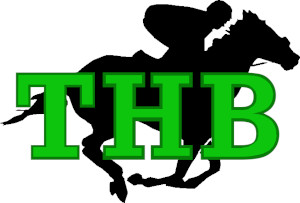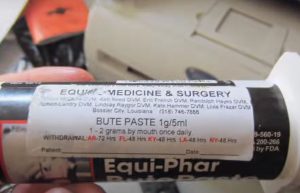The following drugs are illegal for race horses in the United States, Canada, the UK, Ireland, Europe, Australia and most other countries with formal laws covering horse racing. This is not an exhaustive list, but it covers the most common drugs that are banned for racing horses.
Horse Racing Drugs -Illegal vs. Banned vs. Controlled Substances
There are significant differences between a drug being illegal, banned or controlled substances for horse racing.
A drug that is illegal is one where a local, county, state or country government has passed a law specifically defining a drug used on race horses as illegal. In many instances, such as methamphetamines, the drug is an illegal substance that cannot be legally sold to humans or animal owners.
A drug can also be banned by a racing organization or race track. This means that a race horse’s participation in a race is contingent upon not having a detectable amount of a drug in the horse’s blood when tested. Drug bans are created and administered by horse racing organizations and race tracks. Illegal drugs are implicitly banned.
Finally, a drug can be put on a controlled substances list. This typically means that the drug must be purchased, administered and recorded by a licensed veterinarian, according to the stated maximum dosage and timing defined by the organization or government. For example, in the United States, anabolic steroids are allowed to treat race horses, but they cannot be used (detected) on race day. A minimum of 30 days withdrawal period prior to race day is required.
Who Regulates Drugs For Race Horses?
There is significant international and domestic effort and coordination to regulate drug use in horse racing.
In the United States the National Uniform Medication Program led by the Racing Medication and Testing Consortium (RMTC) is working to promote common horse racing drug laws across all 50 states. The Maryland Racing Commission, Kentucky Horse Racing Commission, Association of Racing Commissioners International, and many more organizations all collaborate on horse racing drug regulation and testing.
The United States Equestrian Federation (USEF) has an extensive 2022 Guidelines and Rules For Drugs and Medications (PDF file).
Race horse drug regulation is not limited to Thoroughbred racing. The American Quarter Horse Association has extensive drug guidelines for racing quarter horses. The Arabian Jockey Club specifically follows the RMTC drug dosage and testing guidelines.
In the UK, the British Equine Anti-Doping Rules prohibit doping, steroids, and performance-enhancing drugs in race horses. These rules are in alignment with the FEI rules and are administered by the British Horseracing Authority (BHA).
Across Europe, the anti-drug laws in horse racing are much stronger than in the United States. Race horses, trainers, jockeys and owners can be completely banned from competition if they get caught using anabolic steroids or blood doping compounds.
Internationally, this effort is led by the International Federation of Horseracing Authorities (IFHA), which sets testing, dosage and detectable levels standards in race horses. The Fédération Équestre Internationale (FEI) has an extensive Doping and Medication Control Guide for FEI World Championships. The World Anti-Doping Agency (WADA) establishes and supports detailed drug testing standards for Olympic and other international competitions. These standards are used by the International Olympic Committee (IOC) to police doping and drug use in Olympic competition horses.
Categories of Illegal Drugs Given to Race Horses
Illegal drugs for racehorses can be classified into three broad categories:
- Drugs that affect the horse’s performance
- Drugs that are considered doping agents
- Drugs that are illegal for any animal
Descriptions and examples of drugs which are illegal for race horses in each category are as follows:
Stimulants
Stimulants are drugs that speed up the nervous system. They have the opposite effect of depressants, which slow down brain activity. Stimulants increase alertness, attention and energy levels in a horse. However, stimulants can also cause side effects in race horses such as anxiety and irritability. In high doses, stimulants can lead to psychotic symptoms such as delusions and hallucinations.
These drugs increase alertness, heart rate and blood pressure. They alleviate a race horse’s lethargy and enable the horse to react quickly out of the gates and run harder. They are often used to mask pain and fatigue from over-training. Stimulants can be found in some prescription medications, but they are also common in human street drugs.
Examples of illegal stimulants given to race horses include:
- Amphetamines such as Adderall
- Cocaine
- Methylphenidate (Ritalin)
- Methamphetamine (crystal meth)
- Ephedra
- Nicotine
- Caffeine
Sedatives
Sedatives are central nervous system depressants that slow down brain and nerve activity. They are generally used to treat anxiety and stress in race horses and can be used to calm a horse before racing. Sedatives can be addictive for both humans and equines, and they can be dangerous if used incorrectly.
Types of sedatives included:
- Benzodiazepines
- Barbiturates
- Phenytoin
- Alcohols
- Phenibut is a central nervous system depressant with a significant potential for addiction. It is like the neurotransmitter GABA (gamma-aminobutyric acid) and reduces brain cell sensitivity.
- Xylazine a non-opioid sedative that is often used for horses in veterinary practice
Painkillers
There are many different types of horse painkillers, and they can be classified in a few different ways.
The first way to classify painkillers is by how they work (opoids vs. non-opiods).
The two main types of painkillers are opioids and non-opioids. Opioids work by binding to pain receptors in the brain and spinal cord, while non-opioids work by reducing inflammation or by affecting the nervous system.
- Narcotics are opiod painkiller drugs used on horses and can be addictive. Examples of narcotics include morphine, codeine, and methadone. Because of its potential for misuse in horses for its antitussive and anti-diarrheal properties, codeine is listed as a restricted substance.
- Ketamine is a dissociative medication used to calm horses. It is also known as Special K or K on the street when used illegally by humans.
The second way to classify painkillers is by their strength.
There are three painkiller strengths: mild, moderate, and severe. Mild painkillers include over-the-counter drugs like ibuprofen or aspirin. Moderate painkillers include drugs like hydrocodone or codeine. Severe painkillers include drugs like oxycodone or fentanyl.
The third way to classify painkillers is by their form.
Painkillers can come in many different forms for horses, including pills, capsules, liquids, creams, gels, or injections.
Steroids
Anabolic steroids are artificial hormones that increase muscle mass and strength. This can increase a horse’s performance, particularly sprinting ability. Steroids can also help a horse recover more quickly from fatigue and soft tissue injuries incurred in hard training and races.
Common steroids given to race horses include:
- Stanozolol (formerly sold as Winstrol)
- Boldenone (Equipoise)
- Durabolin
- Testosterone
- Nandrolone
Steroids are generally allowable with withdrawal times of 30 days prior to a race. They banned on race day for race horses competing in the United States and most other countries. For example, the 2021 Kentucky Derby winner Medina Spirit was disqualified after testing positive for the anti-inflammatory steroid betamethasonebetamethasone, which is allowed in Kentucky but prohibited on race day.
Blood Doping Agents
Blood doping is a technique used to improve athletic performance by increasing the amount of oxygen-carrying red blood cells in the bloodstream. Race horse trainers and owners may use blood doping to increase their horse’s endurance by increasing the number of red blood cells.
Blood doping is banned by most horse racing organizations, including ____________________.
There are two main types of blood doping agents: erythropoietin (EPO) and synthetic oxygen carriers (SOCs). EPO is a hormone that stimulate red blood cell production. SOCs are artificial substances that carry oxygen in the bloodstream.
The use of blood doping agents is considered cheating in horse races because it gives horses an unfair advantage. Blood doping can also be dangerous for equines, and can lead to side effects such as heart attacks, strokes and blood clots.
This video shows how prevalent drugs are in horse racing, both for performance and recovery.
Why Are These Drugs Illegal for Race Horses?
There are different reasons why these drugs have been made illegal for race horses.
To Prevent An Unfair Advantage
One of the most common reasons for making a drug used on equines illegal is to prevent cheating. By making these drugs illegal, lawmakers hope to keep horse tracks on a level playing field.
For example, anabolic steroids can be used by a horse owner to gain an unfair speed advantage out of the gates in sprint races.
To Protect the Horse’s Health
The allowed use of drugs in horse racing is primarily intended to help athletic horses build and maintain performance while remaining healthy. For example, the drug Lasix is used to prevent unnecessary pulmonary hemmorhage in race horses after a strenuous run. actually primarily about protecting the horse’s health.
Despite their large size, horses are relatively fragile creatures, with long thin limbs driven by powerful muscles, and sensitive heart-lung and digestive systems. Drugs are allowed to keep horses from getting tired too quickly, to prevent injuries and deaths, and to help horses recover more quickly. While some people argue that this is unfair to the other horses in the race, it is important to remember that these drugs are not used to make the horse run faster, but rather to protect its health.
The illegal drugs listed above have been determined by veterinary science to cause negative effects to equine health, despite their potential short-term benefits. Horses given powerful stimulants, sedatives, steroids or blood doping agents are at increased risk of injury and death. This is inhumane.
Horses that use illegal drugs may suffer from serious side effects, including organ damage and death. If you suspect that a horse has been given an illegal drug, you should contact the authorities. Illegal drug use in horse racing is a serious problem, and it needs to be stopped.
To Protect Jockeys
A horse that falls, collapses or breaks a leg in a high speed race puts the jockey’s life at risk. There are many jockeys that have become paralyzed and even perished from falls in horse races. It is imperative for the jockey’s safety that a horse is able to physically tire and slow, rather than suddenly falling, when it experiences fatigue or an injury. A race horse must be able to feel pain and fatigue to maintain balance and slow safely, and for that, it cannot be on illegal drugs.
To Protect the Public
Drugs like heroin and methamphetamine are considered dangerous because they can lead to addiction and overdoses in humans. Making these drugs illegal in horse racing helps to reduce drug trafficking, and keeps them out of the hands of people who abuse them. These drugs are also illegal because they are seen as immoral in society, and undermine public health.
Related Questions and Answers
What constitutes doping in horse racing?
The use of growth hormones, anabolic steroids that raise testosterone, and so-called blood doping substances, which enable the body to transfer more oxygen to the muscles, is completely prohibited in horse racing, just as it is in athletic competitions.
What drugs are horses tested for?
Race horses are regularly tested for antipsychotic medications, non-steroidal anti-inflammatory medications, anabolic steroids, blood doping substances, and long-acting tranquilizers.
Are horses drug tested before a race?
Horses are subjected to drug testing both before and after races, including endurance races, the Olympics, and FEI-sanctioned events. The timing and frequency of drug testing depends on the horse racing organization.
How do they test for drugs in horse racing?
Pre-race and post-race urine tests are the mainstays of drug testing, with blood tests serving as supplements. Liquid-liquid extraction is a technique used to extract drugs from urine, which is subsequently checked for the presence of illicit substances. Liquid chromatography-mass spectrometry (LC/MS) testing is also used to run the screens.
What does Ketamine do to a horse’s brain?
Ketamine (KET) basically rewrites the areas of the brain producing sadness and anxiety by promoting the development and renewal of neurotransmitters in the brain. After several Ketamine infusions a race horse will generally see a significant increase in mood.
Are steroids allowed in horse racing?
Anabolic steroids are allowed in horse racing in the United States. Steroids are not allowed in the UK, Europe or in any Olympic event.
The U.S. Federal Drug Administration (FDA) allows the anabolic steroids Winstrol, Equipose, Durabolin and testosterone to be administered to race horses for therapeutic purposes.
In the USA, 28 of the 38 states that allow horse racing have no anabolic steroid laws for horses, including Kentucky, New York and Maryland, where the Triple Crown events are held. However, in these states there is a partial prohibition on steroid use, which requires a horse to test negative on race day, and to stop taking anabolic steroids at least 30 days before a race.
In the remaining 10 states, the four anabolic steroid medications commonly used on race horses are not subject to the partial prohibition.
What does Lasix do for a racehorse?
Furosemide (Salix, Lasix) is a diuretic used to help stop pulmonary bleeding in horses with EIPH (Exercise Induced Pulmonary Hemorrhage). The majority of the time, bleeding is avoided by administering a dosage of furosemide and refraining from drinking for at least 4 hours before a race. This allows the horse to urinate out excess fluids that build up in the lungs. It is estimated that 75% of active race horses have some form of EIPH.
Does Lasix calm a horse?
Yes, Lasix has some positive side effects, such as its its soothing impact on a horse, which is often mentioned by trainers. According to a Michigan State University research, Lasix works as a bronchial dilator to increase the amount of oxygen reaching the horse’s lungs. This also helps horses with respiratory diseases other than EIPH, and can have positive side effects for horses under stress due to respiratory pain.
How much does Lasix for horses cost?
Race horses can be administered around $500 worth of Lasix treatments per year at a cost of $20-25 each dose.
Is Lasix banned in the Kentucky Derby?
Yes. In 2021 the Kentucky Derby banned Lasix treatments on race day. This is in line with most major horse racing venues across the globe. The reason is it gives an unfair advantage to the horse by acting as a diuretic and causing the horse to lose 30-40 pounds of water weight when administered about 4 hours before a race.
What is Ace drug for horses?
Acepromazine, often known as Ace or ACP, is used to lightly sedate horses so that owners, veterinarians, and other equine professionals may safely perform regular tasks like trimming, farriery, dentistry, or keeping a horse quiet while on box rest.
Can a horses heart burst?
No. Horse hearts do not burst. Heart-related sudden death in horses is often caused by an electrical event, such as atrial fibrillation, or an aortic arch rupture. Giving the horse an illegal drug such as blood doping agent or stimulants can cause heart failure, but it does not cause a burst heart muscle.
Why are race horses drugged?
Injuries that would ordinarily be too painful for horses on are often covered up with performance-enhancing medicines, enabling them to continue training and racing. This allows the owner to earn more prize money. Breeding and racing horses is very expensive, and winning races pays a lot of money, so there is a powerful incentive for horse owners and trainers to use illegal drugs to enhance horse performance and recovery.
Is Regumate competition-legal?
For stallions and geldings, Altrenogest (Regumate®) has been transferred from the Banned list to the Controlled Medications list. This means Regumate is competition legal, but must be properly administered by a veterinarian.
Regumate is allowed in mares If proper FEI medicine paperwork is submitted. This means it is competition legal, also when administered and documented by a veterinarian.
What are horse tranquilizer pills?
Horse tranquilizer pills come in a variety of forms. However, the most common is xylazine, a non-opioid sedative pill used for horses in veterinary practice.
Was Rich Strike drugged?
The Kentucky Horse Racing Commission declared that all drug tests for Rich Strike from the 2022 Kentucky Derby. The results confirmed Rich Strike’s incredible victory against 80:1 odds in the 148th Run for the Roses.
Did the horse that won the 2021 Kentucky Derby test positive for steroids?
Medina Spirit’s victory in the 2021 Kentucky Derby was revoked when the thoroughbred tested positive for the anti-inflammatory steroid betamethasonebetamethasone. This steroid is permitted for treatment of horses in Kentucky but prohibited on race day.
Related Topics
- what drugs are used in horse racing
- are drugs dangerous for race horses
- banned drugs in horse racing
- permitted drugs in horse racing
- illegal drugs in horse racing

I am Lawrence (aka “The Horse Better”). I spent 20+ years in financial risk management where I ran large-scale statistical betting models in complex situations. I grew up around horses and I’ve been betting on horse races for about 10 years with good success. I hope my articles provide good value!

